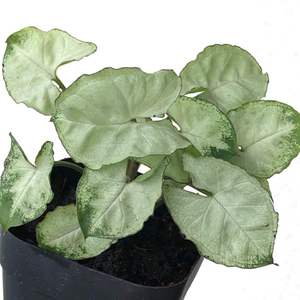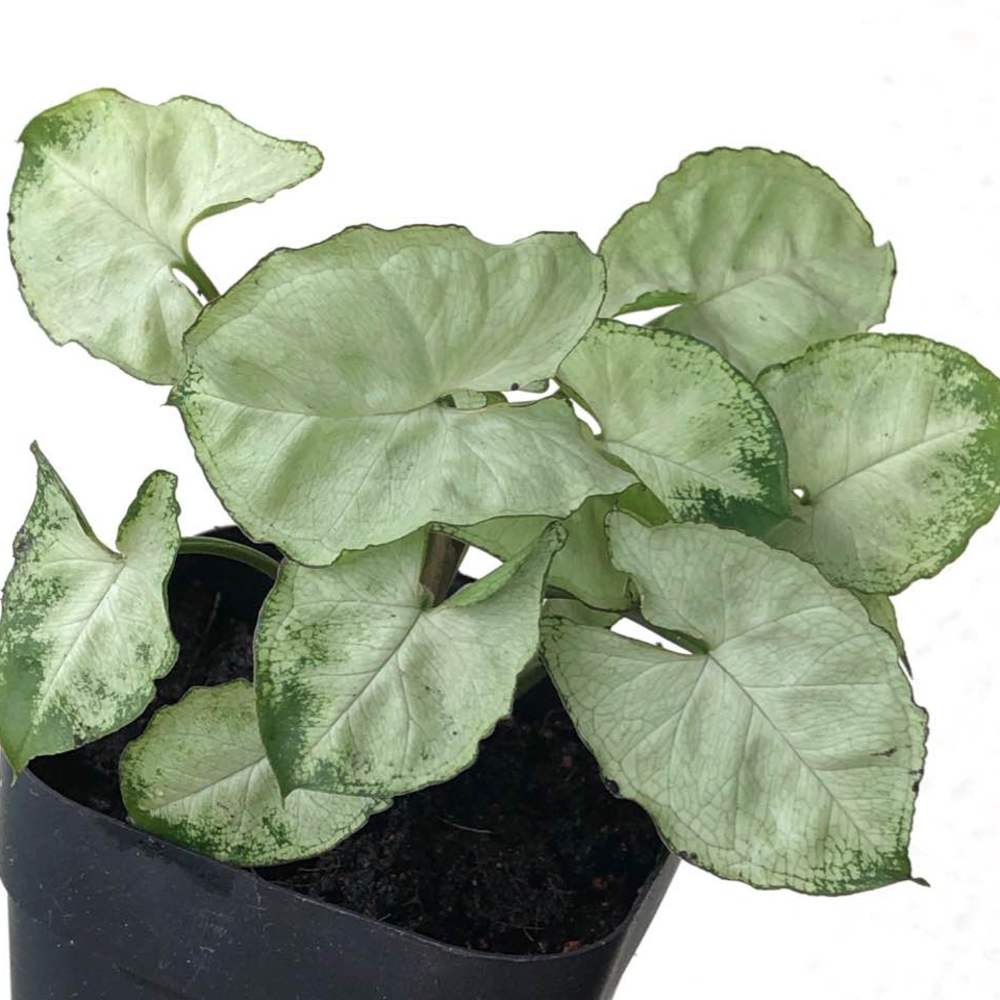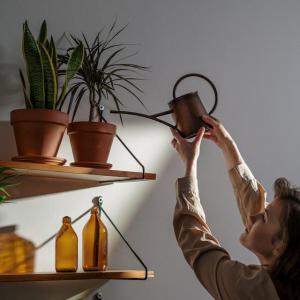Plant Experience
Detail
This low-maintenance houseplant is interesting and versatile. It is available in a range of colors, and the attractive foliage changes in shape as the individual leaves mature. This hardy evergreen vine is an enthusiastic climber, but it can be pruned to create a compact tabletop plant.
When left unpruned, its vines can grow to be about six feet long and are lovely when trained to climb or allowed to cascade over the sides of a hanging basket.
Foliage: Leaves vary in color depending upon the plant variety. On all varieties, leaves transform from small ovate leaves too long, lobed leaves. Color and markings also change throughout the lifespan of the leaf.
When leaves first emerge, they are relatively heart-shaped and often display silvery variegation. When they become mature, they attain the arrowhead shape that gives them their common name. As the leaves further mature, they grow from about five inches long to about fourteen inches long.
Colors: Leaves are usually heavily variegated when young. The variegation tends to fade as the leaves mature. Leaves come in attractive shades of green and white, silver, cream, pink and even purple.
Syngonium Plant Care Requirements:
Light: These plants do well in low-to-medium light settings and thrive in bright, indirect light. They do not like exposure to direct sunlight. If you are only able to provide low-to-medium light conditions, you may do better with one of the deeper green varieties. These tend to do better in shaded conditions.
Water: The soil should be kept lightly moist during spring and summer and slightly drier during the fall and winter months. Don’t let it become completely dry. The plant is undemanding when it comes to watering, but does prefer high humidity, so it’s a good idea to place container plants on a bed of wet pebbles. Mist hanging baskets frequently. Water moderately throughout the growing season and reduce watering during cooler months.
Temperature: As a semi-tropical plant, this vine prefers warm, humid conditions. Try not to allow the temperature to drop below 60 degrees Fahrenheit.
Soil: Use a rich potting mix that offers superior draining and aerating capabilities.
Fertilizer: Use a balanced liquid houseplant food on a regular basis during the spring and summer. Follow package directions closely.
Problems: These hardy plants have no pests or diseases problems when cared for properly. Maintain a moderate watering schedule and provide the right sort of substrate to prevent:
Root rot
Bacterial leaf spot
Colonies of Spider mites
Scale on plants
Aphids
Sap sucking Mealybugs
All of these can be problematic on over watered plants, but should not plague healthy plants.
Pruning: If you want to keep your plant compact and bushy, pinch of new growth on a regular basis. Wear gloves when pinching as the plants’ sap can cause skin irritation.
Propagation: It is easy to root Syngonium from cuttings during the growing season. Cut sections of stem containing root nodes and place them in clean water to grow roots. If you see that your plant has developed aerial roots on the stem, you can be certain that stem section will root easily.
Repotting: Generally, you should refresh the potting soil in the springtime and repot every other year; however, because these plants are fast-growers you may need to repot annually. Frequent repotting will result in even faster growth!
When left unpruned, its vines can grow to be about six feet long and are lovely when trained to climb or allowed to cascade over the sides of a hanging basket.
Foliage: Leaves vary in color depending upon the plant variety. On all varieties, leaves transform from small ovate leaves too long, lobed leaves. Color and markings also change throughout the lifespan of the leaf.
When leaves first emerge, they are relatively heart-shaped and often display silvery variegation. When they become mature, they attain the arrowhead shape that gives them their common name. As the leaves further mature, they grow from about five inches long to about fourteen inches long.
Colors: Leaves are usually heavily variegated when young. The variegation tends to fade as the leaves mature. Leaves come in attractive shades of green and white, silver, cream, pink and even purple.
Syngonium Plant Care Requirements:
Light: These plants do well in low-to-medium light settings and thrive in bright, indirect light. They do not like exposure to direct sunlight. If you are only able to provide low-to-medium light conditions, you may do better with one of the deeper green varieties. These tend to do better in shaded conditions.
Water: The soil should be kept lightly moist during spring and summer and slightly drier during the fall and winter months. Don’t let it become completely dry. The plant is undemanding when it comes to watering, but does prefer high humidity, so it’s a good idea to place container plants on a bed of wet pebbles. Mist hanging baskets frequently. Water moderately throughout the growing season and reduce watering during cooler months.
Temperature: As a semi-tropical plant, this vine prefers warm, humid conditions. Try not to allow the temperature to drop below 60 degrees Fahrenheit.
Soil: Use a rich potting mix that offers superior draining and aerating capabilities.
Fertilizer: Use a balanced liquid houseplant food on a regular basis during the spring and summer. Follow package directions closely.
Problems: These hardy plants have no pests or diseases problems when cared for properly. Maintain a moderate watering schedule and provide the right sort of substrate to prevent:
Root rot
Bacterial leaf spot
Colonies of Spider mites
Scale on plants
Aphids
Sap sucking Mealybugs
All of these can be problematic on over watered plants, but should not plague healthy plants.
Pruning: If you want to keep your plant compact and bushy, pinch of new growth on a regular basis. Wear gloves when pinching as the plants’ sap can cause skin irritation.
Propagation: It is easy to root Syngonium from cuttings during the growing season. Cut sections of stem containing root nodes and place them in clean water to grow roots. If you see that your plant has developed aerial roots on the stem, you can be certain that stem section will root easily.
Repotting: Generally, you should refresh the potting soil in the springtime and repot every other year; however, because these plants are fast-growers you may need to repot annually. Frequent repotting will result in even faster growth!
Album (2)


kensong
2018-10-13

This is my first growing diary. Gift from Mona Lim.




Elite Article













